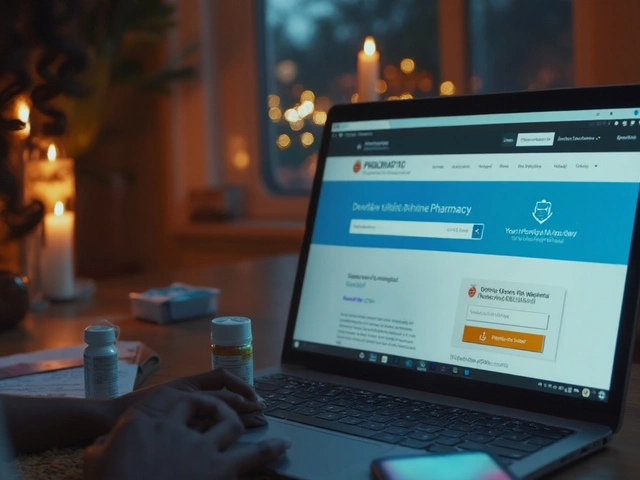Imagine struggling just to catch your breath while trying to enjoy a walk outside or even sipping your morning coffee. For millions, that's the reality of COPD and other chronic breathing problems. Tiova Rotacap has jumped into the mix as a real game-changer, putting power back in the hands (and lungs) of people who are tired of wheezing their way through life. This little capsule packs a punch, but there’s a lot folks don’t know—like what makes it work, the best way to use it, what to expect, and how to get the most out of it. Here's everything you need if you’ve ever picked up a Rotacap or are just curious about smarter breathing solutions.
What Exactly Is Tiova Rotacap?
Tiova Rotacap isn’t some mysterious new supplement—it’s a prescription medicine made to tackle the symptoms of chronic obstructive pulmonary disease (COPD) and other breathing issues like chronic bronchitis and emphysema. The star in each Rotacap is tiotropium bromide, a long-acting bronchodilator. Here’s what’s cool: it works by relaxing the muscles around your airways so they stay open, making it easier to pull air all the way into your lungs and kick carbon dioxide out. It doesn’t fix the disease, but it sure can make every breath smoother.
Doctors across the globe hand out Tiova Rotacap for the long haul—it’s not a one-and-done treatment. The effect builds up through daily use. It's got a pretty solid track record. The European Respiratory Journal published a big study back in 2023 showing patients who used tiotropium breathed easier, walked longer distances, and had fewer flare-ups over a 12-month period. Not a miracle, but for folks who just want to garden without gasping or play with grandkids, it’s a real upgrade.
The capsule itself isn’t swallowed. You put it into a special inhaler device (Rotahaler), poke the cap to release the powder, breathe in deeply—and boom, medicine goes straight to the lungs where it’s needed most. No system wasted, no time lost. For people worried about pill fatigue, that’s a win. Tiova Rotacap offers a straight shot to the source of the problem without all the mess of oral meds or needles.
Flip the box over and you’ll see the dosage: usually one 18mcg capsule once daily, but always double-check with your doc. Some folks want to double up, thinking more is better—not the move. Doing so doesn’t make you breathe better, but it can crank up side effects. Think racing heart, a dry mouth that won’t quit, or trouble peeing. That’s why clear dosing matters.
How Tiova Rotacap Helps Ease Life with COPD
Living with COPD isn’t just about coughing or feeling short of breath—there’s the constant worry about flare-ups or trips to the ER. Tiova Rotacap swings in with a pretty clear mission: stop those unexpected bad days before they start. One of its biggest upsides is how it keeps the airways open for 24 hours at a stretch. This is huge for night-time symptoms; patients report waking up less often, which means better sleep, more energy, and a bit of normalcy in the day-to-day grind.
The magic inside the Rotacap, tiotropium, blocks something called muscarinic receptors in your air passages. Without getting all science heavy: most folks with COPD have tightened airways and extra mucus floating around. By blocking these receptors, tiotropium lets those airways chill out and open wide all day. Consistency is key, though. If you skip days or don’t use it regularly, you don’t get the full benefit. You wouldn’t expect to build muscle by going to the gym once a week, right? Same deal here.
What about walking farther or doing chores? In a 2023 clinical survey, about 67% of Tiova Rotacap users said they could handle their daily routine better within a month of steady use. No, it won’t erase the disease, but just being able to climb stairs or tidy up without sitting down every five minutes can change a person’s outlook.
This doesn’t mean you toss other treatments out the window. Tiova Rotacap often works as part of a bigger COPD plan—think rescue inhalers for sudden attacks, steroids during flare-ups, or even oxygen therapy for advanced cases. The Rotacap handles the day-to-day heaviness, but always talk to your doctor before mixing therapies.

How to Use Tiova Rotacap: Step-By-Step
You’d be surprised how many people use inhalers wrong—even nurses admit it’s a common slip. Using Tiova Rotacap right makes all the difference, otherwise half the medicine ends up stuck in your mouth or on the floor. Here’s the simple, no-nonsense way to get it right every time:
- Wash and dry your hands first. This isn’t just a hygiene thing—any moisture can gum up the Rotacap powder.
- Take your Rotahaler device and open it as per the instructions. Pop a Rotacap in the capsule chamber.
- Twist the Rotahaler back so it’s ready. The device will pierce the capsule, setting loose a fine dry powder.
- Breathe out, but not into the device—you don’t want to blow powder everywhere!
- Seal your lips around the mouthpiece, breathe in sharply and deeply. The powder heads straight to your lungs, which is the jackpot.
- Hold your breath for about 10 seconds. Think of it like letting the medicine settle so it doesn’t escape.
- Pull out the Rotahaler and exhale slowly. Don’t rush to talk or eat until you’re done.
- Open the device, throw away the empty capsule shell, and close it up. Rinse your mouth with water to ditch the aftertaste and lower your risk of throat irritation.
Here’s an extra tip: if you ever cough right after inhaling, wait a minute and try again with a new capsule. And never, ever swallow the capsule. Sounds obvious, but mistakes happen, especially if you’re new to dry powder inhalers.
Want to know if you’re inhaling right? Keep an eye on your symptoms. If you’re still wheezing or feel like you just got half a dose, chat with your doctor or pharmacist. Sometimes a quick demo helps more than reading the instruction sheet for the fifth time.
What to Expect: Side Effects, Interactions, and Safety Tips
No medicine is perfect, and Tiova Rotacap isn’t an exception. Most people handle it well, but there are some things to watch for. Dry mouth is the classic sidekick—it hits about a quarter of users, but usually fades over weeks. If sucking on ice chips or sipping water often doesn’t cut it, let your doctor know. Some folks get throat irritation or voice changes (think raspy, like you cheered too hard at a soccer match).
Less common but possible—urinary retention (trouble peeing), rapid heartbeat, constipation, or blurred vision. Catch any of these? Make a note and bring it up at your next visit. Severe allergic reactions are rare but serious—if you have swelling, hives, or trouble swallowing, call for help right away.
What about mixing with other meds? Good question. Since tiotropium is an anticholinergic, you want to be careful with similar drugs (for example, ipratropium or certain allergy medicines). Double-dosing on anticholinergics can make side effects way worse. And because COPD is tricky, it’s normal for folks to be on a few different drugs—just make sure your doctor knows what you’re taking.
Smoking? Still a big no. Even if you’re on Tiova Rotacap, lighting up cancels out a lot of the benefit. Make quitting a priority—there's plenty of support out there for that goal.
For pregnant women or nursing moms, the jury’s still out. Most doctors suggest staying clear of Tiova Rotacap unless the benefits really outweigh the risks. Chat with your healthcare provider for the best advice based on your situation.
Here’s a quick stats table to show reported side effects from a 2024 Indian patient pool (n=600):
| Side Effect | Frequency |
|---|---|
| Dry Mouth | 27% |
| Throat Irritation | 13% |
| Cough | 8% |
| Urinary Retention | 6% |
| Constipation | 5% |
| Blurred Vision | 4% |
| Allergic Reaction | <1% |
Pay attention to your body, jot down any new symptoms, and always loop your doctor in if something feels off. Knowledge trumps guesswork every time.

Tips for Getting the Most Out of Your Tiova Rotacap
Consistency makes the real difference—it isn’t just about remembering to take your Tiova Rotacap, but also sticking to the same time every day. That way, there’s always a steady level of medicine in your system. Pick a moment that sticks, like after brushing your teeth in the morning. Link it to another habit to make it fool-proof.
If you miss a dose, the rule is easy: skip it if it’s almost time for your next one. Don’t double up. Most folks won’t see a big dip from a single missed dose, but getting thrown off schedule too often weakens the benefit. Some people set a phone alarm as a daily trigger, or just leave the Rotacap somewhere obvious as a reminder.
Sterilize your device once a week. Just keeping your Rotahaler clean does wonders for cutting down on germs and making sure each dose gets delivered just right. Most devices come apart easily—warm water and a soft brush do the trick. Let it dry completely before your next use, so powder doesn’t clump up.
Traveling? Keep your Rotacaps in a dry, dark spot. Humidity can mess with the powder, making it lumpy and less effective. If you’re headed somewhere new, double up on devices in case one breaks or gets lost. A simple carry case or sturdy zip bag keeps things safe. And have your prescription info handy, especially when flying—airport security has gotten pickier about inhalers and capsules in carry-ons, so having paperwork smooths things over.
Don’t share your inhaler—even if someone has the same prescription. It’s easy to pass germs and mess up dosing. Everyone’s prescription is tailored. And if you’re ever unsure about anything, whether it’s refill schedules or whether Tiova Rotacap is still right for you as your COPD changes, your doctor or respiratory therapist is your best ally. There’s no shame in asking for a refresher—health is too important for pride.
There’s a big mental side to all this too. Managing COPD is a marathon, not a sprint. Surround yourself with people who get it—support groups (online and off), family, or friends willing to walk with you. Staying positive and proactive trumps going it alone. The people who keep at it every day, one inhaler at a time, are proof that better breathing is possible.
Your journey with Tiova Rotacap is yours, but you don’t have to walk it solo—science, real talk, and community make every breath go a bit further.





Michael Wall
August 14, 2025 AT 18:03Good practical breakdown, I appreciate the step-by-step on using the Rotahaler because most people mess that up.
Tiotropium as a once-a-day option really changes the daily rhythm for people with COPD, and calling out the 18mcg standard dose was useful since folks sometimes try to up it and cause a mess.
The part about not swallowing the capsule and keeping the device dry is spot on, moisture ruins these powders fast.
I also like that the write-up emphasized Tiova as part of a wider treatment plan rather than a lone miracle cure, that’s the reality.
One practical thing to add is to show newer patients the inhaler once or twice at the clinic so they actually do it right at home.
Matthew Tedder
August 16, 2025 AT 04:06Nice overview, straight to the point and full of useful bits.
For anyone starting Tiova, consistency really matters and linking the dose to a habit like brushing teeth is exactly the kind of small behavior trick that works long term.
Also want to emphasize the social side - caregivers and family knowing how to load the capsule and clean the device cuts down on missed doses a lot.
Travel advice was solid too, a dry place and a spare device are underrated tips that save stress on trips.
People get better outcomes when they pair the inhaler with activity pacing and pulmonary rehab, that synergy is huge.
Overall, treat the inhaler as part of daily routine rather than a last resort, that mindset shift helps maintain gains.
Raja Asif
August 17, 2025 AT 13:26Big respect for the Indian patient data being included, that's the kind of local evidence people need.
We make and use these devices widely here and seeing stats helps push adoption instead of blind fear.
Keep pushing for manufacturing standards and availability across regions, medicine should be for everyone.
Yassin Hammachi
August 18, 2025 AT 22:46Tiova Rotacap matters because breathing is the baseline of freedom for every ordinary day, and any treatment that reliably restores even a bit of that baseline deserves careful attention and daily practice.
There is a philosophical layer to using long-acting bronchodilators that most write-ups ignore, and it's not about chasing a cure but about negotiating a life that remains meaningful despite chronic illness.
Every inhale taken correctly is an act of quiet stewardship over one's remaining capacities, and making that inhale count requires more than a label on a box.
Training, habit, and community matter as much as the active molecule, because the drug is only as effective as the human systems that deliver and sustain it.
On the practical side, the Rotahaler technique is an embodied skill and should be taught with repetition until it becomes second nature, otherwise the pharmacology on the label stays theoretical.
Consistency produces measurable gains in daily functioning and mood, which then feed back into better self-care routines and fewer emergency interventions.
It is important to insulate the device from humidity and to check for capsule integrity every time before use, because the small failures compound over weeks and erode trust in treatment.
Side effects like dry mouth and urinary retention are not just clinical footnotes, they alter people's relationship with medication and can create avoidance behavior that undermines therapy.
Therefore clinicians should preemptively counsel about these effects and offer simple mitigation strategies, turning potential drop-outs into manageable side notes.
Adding Tiova into a care plan should be a negotiated step where goals are clear: improved sleep, clearer mornings, fewer flare-ups, and steady participation in daily life.
When those goals are explicit and tracked, the subjective benefit aligns with objective measures and adherence rises.
Support systems are crucial - a family member who checks the device once a week or a pharmacist who demonstrates technique can change an outcome profile substantially.
Medical decisions are embedded in social contexts and any respiratory regimen that ignores that will underperform.
Finally, framing the inhaler as a tool for possibility rather than a badge of decline helps people stick with treatment without shame, which is its own therapeutic multiplier.
Cynthia Sanford
August 20, 2025 AT 08:06Glad to see hope in a single line of treatment.
Sam Franza
August 21, 2025 AT 17:26Agree on showing patients how to use it, live demos beat leaflets any day.
Brooks Gregoria
August 23, 2025 AT 02:46Looks like another overhyped drug write-up dressed up as useful advice.
Tiotropium is effective for some, sure, but the piece reads like a sales brochure more than a critical analysis and people deserve a straight take on cost, access, and alternative strategies.
There are cheaper management techniques and rehab programs that get less press because they don't have a pill bottle attached.
Celebrating once-daily dosing is fine until a patient can't afford the refill and then the benefit evaporates overnight.
Context matters more than cheerleading, and I say that as someone who wants people breathing better, not just buying into another branded option.
Jason Lancer
August 24, 2025 AT 12:06Nice try, pamphlet vibes. But the everyday reality is messier.
Patients get mixed messages and then skip meds or double up, which blows up in the clinic later.
Also that table of side effects looks neat until you add the real-life polypharmacy most of these folks are on.
People with COPD are often older and on five-plus meds and the anticholinergic load is not a theoretical problem.
So yeah, this is useful reading, but it would have helped to hit harder on drug interactions and deprescribing strategies.
Irene Harty
August 25, 2025 AT 21:26The safety section should have been front and center because people need to see risks before enthusiasm takes over.
Regulatory gaps and promotional language can obscure real limitations and the piece does not dwell enough on contraindications or pregnancy data.
Clear, formal warnings about combining anticholinergics and the need for medication reconciliation would have improved the guidance greatly.
Readers should be told explicitly to bring a complete drug list to every appointment and to document urinary or vision changes in a daily log.
Missing that step leaves patients at risk and shifts the burden onto overworked clinicians to catch preventable side effects later.
Christopher Xompero
August 27, 2025 AT 06:46omg this makes me feel so dramatic but like seriously, the bit about holding breath for ten seconds is underrated drama
i always cough on the first try and then feel like the inhaler is mocking me
bruh the powder flies everywhere if you mess up and it's humiliating in busy clinic rooms
still worth it tho, i've seen small wins where walking a block didn't end in a wheeze-fest
Michael Wall
August 28, 2025 AT 16:06Thanks for the support earlier, and that live demo point really matters in practice.
Clinics that run a quick inhaler skills station cut down follow-up calls and phone panic texts from patients trying to figure it out alone.
It doesn't take much time but the payoff in adherence and fewer exacerbations is measurable.
Raja Asif
August 30, 2025 AT 01:26Buying locally made devices and ensuring quality checks should be a priority in rollout programs.
We have the capacity to scale production but regulators and procurement need to sync up on standards to avoid cheap knockoffs getting distributed.
Sam Franza
September 4, 2025 AT 17:33One clear path forward is simple: combine inhaler training, a reminder habit, and a weekly device check and you get better real-world results than with a pamphlet alone.
Healthcare systems should fund short training slots because the downstream savings from fewer ER visits are obvious.
It takes a tiny investment in time and attention to turn a prescription into a reliable daily benefit.
Yassin Hammachi
September 11, 2025 AT 16:13Adding to the point about training, integrate a brief functionality check into routine follow-ups so clinicians can observe inhaler technique in two minutes and correct it on the spot.
That small habit reduces wasted doses and prevents months of silent underdosing that shows up later as deterioration.
Also document subjective improvements as well as objective measures so patients stay engaged with visible wins.
This keeps therapy aligned with life goals and not just numbers on a chart.